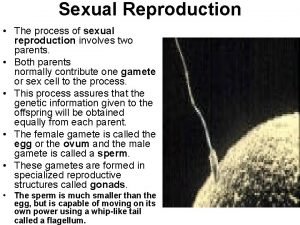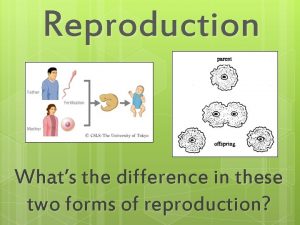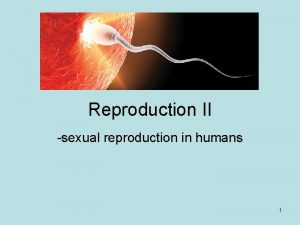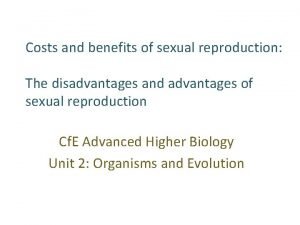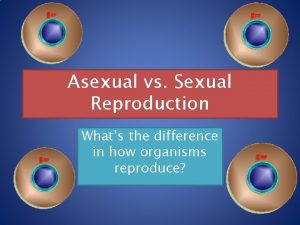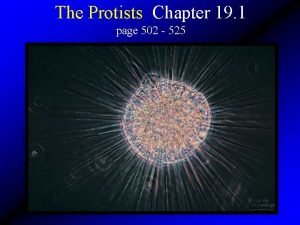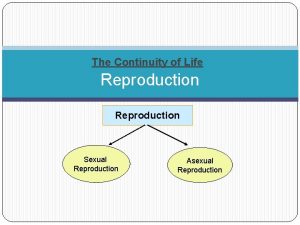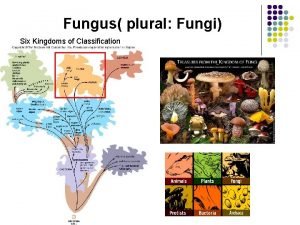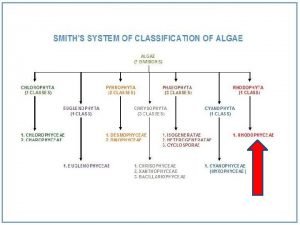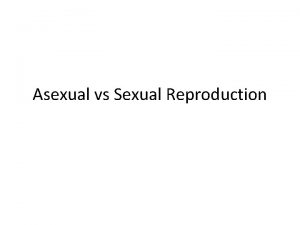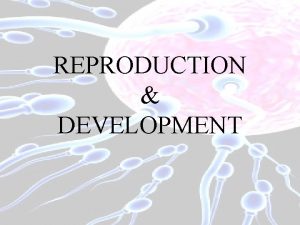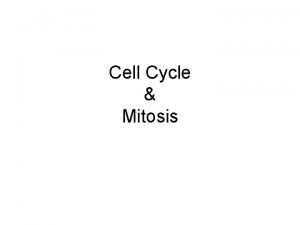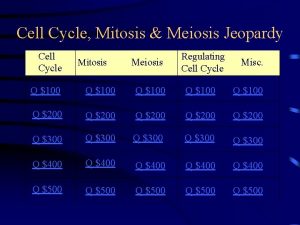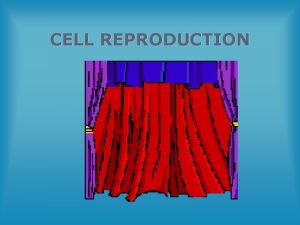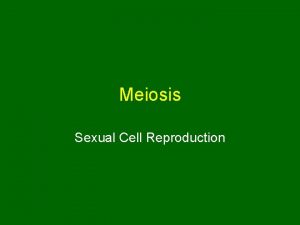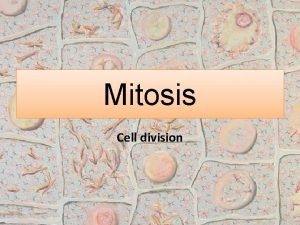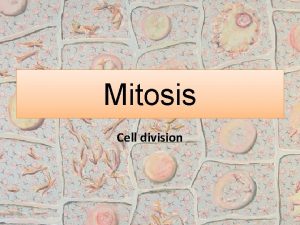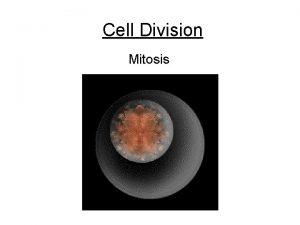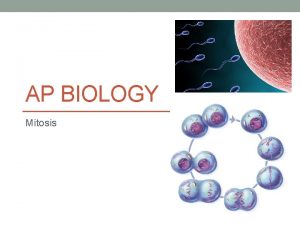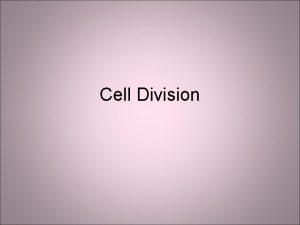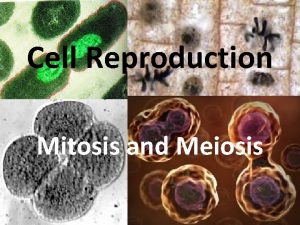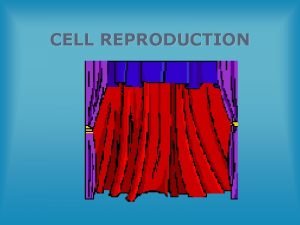THE CELL CYCLE Mitosis SEXUAL REPRODUCTION Sexual reproduction








































- Slides: 40

THE CELL CYCLE Mitosis

SEXUAL REPRODUCTION Sexual reproduction leads to genetic variation within a population of organisms. This means that all organisms are not identical.

THE CELL CYCLE - MITOSIS Scientists describe the cell cycle as a process by which a parent cell grows, duplicates itself and divides to produce new cells.

https: //www. youtube. com/watch? v= Q 6 uc. KWIIFmg


• INTERPHASE • MITOSIS • CYTOKINESIS


1. INTERPHASE The cell prepares itself for division. A cell’s genetic information directs all of the cells functions and is stored in the form of long molecules of DNA.

1. INTERPHASE Each double-stranded DNA molecule is packaged into a structure called a chromosome.

In preparation for cell division, the chromosomes are duplicated and then condense. Each chromosome is made up of two identical copies of DNA. ANIMAL CELL PLANT CELL

2. MITOSIS DURING MITOSIS THE NUCLEUS DIVIDES MITOSIS HAS FOUR STAGES PROPHASE, METAPHASE, ANAPHASE AND TELOPHASE

STAGE 1: PROPHASE The chromosomes which were duplicated during interphase, condense and shorten.

STAGE 1: PROPHASE The membrane around the nucleus begins to dissolve and disappear.

STAGE 1: PROPHASE The mitotic spindle appears.

PROPHASE


STAGE 2: METAPHASE The doubled chromosomes line up in the middle of the cell on the mitotic spindle.

STAGE 2: METAPHASE The membrane around the nucleus is completely dissolved.

METAPHASE


METAPHASE ANIMAL CELL PLANT CELL

STAGE 3: ANAPHASE The chromosome strands separate and move to opposite ends of the cell.

STAGE 3: ANAPHASE The two sets of chromosomes are identical and have exactly the same genetic information.

ANAPHASE


ANAPHASE ANIMAL CELL PLANT CELL

STAGE 4: TELOPHASE The separated chromosomes arrive at opposite sides of the cell. The mitotic spindle disappears.

STAGE 4: TELOPHASE A new nuclear envelope beings to form around each set of chromosomes, forming two new nuclei.

TELOPHASE

TELOPHASE ANIMAL CELL PLANT CELL


3. CYTOKINESIS In animal and plant cells, the cell membrane pinches in to divide the nuclei, cytoplasm, and organelles to form two daughter cells.

3. CYTOKINESIS After cytokinesis the cells are in interphase and the cell cycle begins again.

CYTOKINESIS

1. INTERPHASE 2. PROPHASE 3. METAPHASE 4. ANAPHA



1. INTERPHASE 3. METAPHASE 2. PROPHASE 4. ANAPHASE


5. TELOPHASE 6. CYTOKINESIS
 Sexual and asexual reproduction
Sexual and asexual reproduction Asexual reproduction cell division
Asexual reproduction cell division Asexualk
Asexualk Asexual and sexual reproduction venn diagram
Asexual and sexual reproduction venn diagram Essential idea
Essential idea Concept map meiosis
Concept map meiosis Cell cycle phases in order
Cell cycle phases in order Bioflix activity: mitosis -- events of mitosis
Bioflix activity: mitosis -- events of mitosis Events of the cell cycle
Events of the cell cycle Cell cycle and cell division
Cell cycle and cell division Biology.arizona.edu/cell bio/activities/cell cycle/01.html
Biology.arizona.edu/cell bio/activities/cell cycle/01.html A sexual reproduction in humans
A sexual reproduction in humans Chapter 20 sexual reproduction in animals packet answers
Chapter 20 sexual reproduction in animals packet answers Define reproduction
Define reproduction Define sexual reproduction
Define sexual reproduction Section 1 meiosis
Section 1 meiosis Whats sexual reproduction
Whats sexual reproduction A sexual reproduction in humans
A sexual reproduction in humans Chapter 10 sexual reproduction and genetics
Chapter 10 sexual reproduction and genetics Parthenogenesis asexual reproduction
Parthenogenesis asexual reproduction Connecting the concepts sexual reproduction
Connecting the concepts sexual reproduction Chapter 10 section 3 gene linkage and polyploidy
Chapter 10 section 3 gene linkage and polyploidy Connecting the concepts sexual reproduction
Connecting the concepts sexual reproduction Whats asexual reproduction
Whats asexual reproduction Reproduction in organism
Reproduction in organism Disadvantages of sexual reproduction
Disadvantages of sexual reproduction Two types of reproduction
Two types of reproduction Significance of sexual reproduction
Significance of sexual reproduction Advantages of genetic diversity
Advantages of genetic diversity Animal chromosome number
Animal chromosome number Venn diagram sexual and asexual
Venn diagram sexual and asexual Chapter 19 protists study guide answers
Chapter 19 protists study guide answers Sexual or asexual reproduction
Sexual or asexual reproduction Fungi plural
Fungi plural Division rhodophyta includes
Division rhodophyta includes Chapter 10 sexual reproduction and genetics
Chapter 10 sexual reproduction and genetics Sexual or asexual reproduction
Sexual or asexual reproduction Sexual reproduction
Sexual reproduction Asexual or sexual reproduction
Asexual or sexual reproduction External fertilization
External fertilization Requires two parents
Requires two parents













